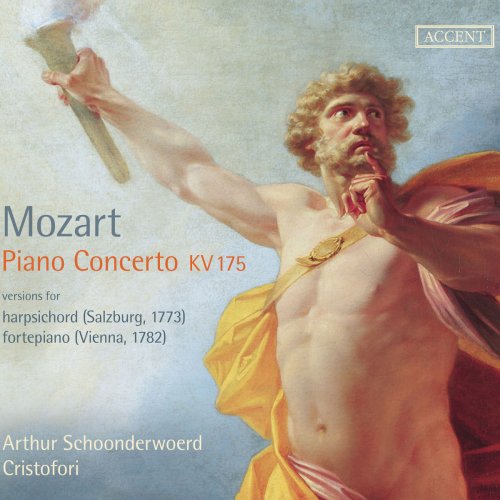
Arthur Schoonderwoerd - Mozart: Piano Concerto No. 5, K. 175 (2014)
BAND/ARTIST: Arthur Schoonderwoerd, Cristofori, Johannette Zomer
- Title: Mozart: Piano Concerto No. 5, K. 175
- Year Of Release: 2014
- Label: Accent
- Genre: Classical
- Quality: FLAC (tracks)
- Total Time: 57:29
- Total Size: 294 MB
- WebSite: Album Preview
Tracklist:
01. Piano Concerto No. 5 in D Major, K. 175: I. Allegro (1773 Version)
02. Piano Concerto No. 5 in D Major, K. 175: II. Andante ma un poco adagio (1773 Version)
03. Piano Concerto No. 5 in D Major, K. 175: III. Allegro (1773 Version)
04. Ah, lo previdi, K. 272: Recitativo. Ah, lo previdi!
05. Ah, lo previdi, K. 272: Aria. Ah, t'invola
06. Ah, lo previdi, K. 272: Recitativo. Misera! Misera!
07. Ah, lo previdi, K. 272: Cavatina. Deh, non varcar
08. Piano Concerto No. 5 in D Major, K. 175: I. Allegro (1782 Version)
09. Piano Concerto No. 5 in D Major, K. 175: II. Andante ma un poco adagio (1782 Version)
10. Piano Concerto No. 5 in D Major, K. 175: Rondo, K. 382 (1782 Version)
01. Piano Concerto No. 5 in D Major, K. 175: I. Allegro (1773 Version)
02. Piano Concerto No. 5 in D Major, K. 175: II. Andante ma un poco adagio (1773 Version)
03. Piano Concerto No. 5 in D Major, K. 175: III. Allegro (1773 Version)
04. Ah, lo previdi, K. 272: Recitativo. Ah, lo previdi!
05. Ah, lo previdi, K. 272: Aria. Ah, t'invola
06. Ah, lo previdi, K. 272: Recitativo. Misera! Misera!
07. Ah, lo previdi, K. 272: Cavatina. Deh, non varcar
08. Piano Concerto No. 5 in D Major, K. 175: I. Allegro (1782 Version)
09. Piano Concerto No. 5 in D Major, K. 175: II. Andante ma un poco adagio (1782 Version)
10. Piano Concerto No. 5 in D Major, K. 175: Rondo, K. 382 (1782 Version)
Mozart's Piano Concerto No. 5 in D major, K. 175, was his first true keyboard concerto; the first four were arrangements of music by J.C. Bach and other composers. Written in 1773 when Mozart was 15, it was performed again in 1782, with the work now known as the Rondo in D major, K. 382, as a new finale. Why Mozart replaced the finale is not known; the reason given in the booklet here, that Mozart felt the earlier fugal piece was out of style, is unsatisfactory given Mozart's burgeoning interest in counterpoint in the early 1780s. At any rate, the later performance was clearly not given on a harpsichord; the K. 382 finale includes notes beyond the range of harpsichords of the time. Thus a fortepiano was probably used. Here the work is performed in two versions: the earlier one on harpsichord and the later one not on fortepiano but on a tangent piano, an extremely rare transitional instrument between harpsichord and piano. No argument explaining the use of the tangent piano is given, but probably the primary market for the release will be among those curious as to what it sounds like. Another unique feature is the presence of hypothetical flute parts in the first two movements, reconstructed from altered oboe and horn parts. The new finale included flutes, but the evidence for there having been a missing pair of flute parts for the first two movements is slender. The presence of the fine Dutch soprano Johannette Zomer in the little known recitative and aria Ah, lo previdi, K. 272, is a plus, but the sound, from a Besançon church, is a major disincentive: even though the orchestra consists of but one player per part (a questionable decision in itself), it drowns out the little keyboard instruments, surrounded in a sea of booming resonance. Of interest primarily to those absorbed in historical keyboard issues. ~ James Manheim
As a ISRA.CLOUD's PREMIUM member you will have the following benefits:
- Unlimited high speed downloads
- Download directly without waiting time
- Unlimited parallel downloads
- Support for download accelerators
- No advertising
- Resume broken downloads


